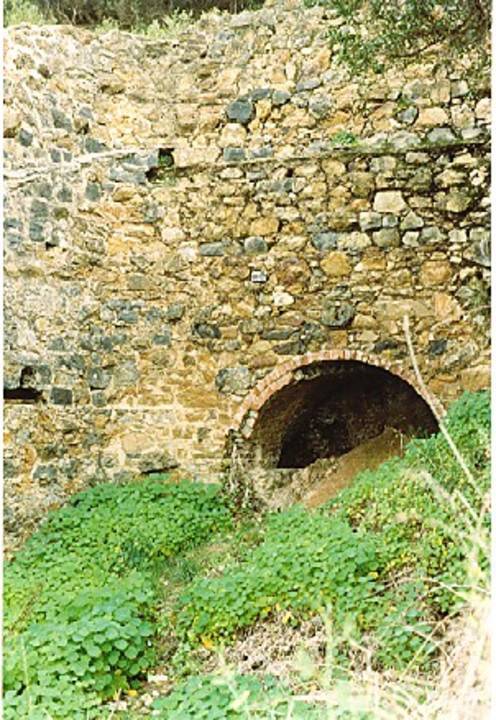| Back to search results » | Back to search page » |
|
Remains Walkerville Lime Kilns
LocationOff Bayside Drive,, WALKERVILLE VIC 3959 - Property No B1840
File NumberB1840LevelRegional |
|
Statement of Significance
The site contains the remains of six stone and brick lime kilns built in 1875 by a Melbourne shipping firm, Bright Brothers. Production began in 1878 under the ownership of W H Wischer, who was joined in 1881 by W F Walker. The company was registered under the name Waratah Lime & Cement Co in 1894. The town was orignally known as Waratah, but the name was changed in the 1890s to Walkerville after the owner of the lime kilns. The kilns were closed in 1926.
Remains of workers' cottages can be seen at the top of the cliff north-west of the kilns, and on the slopes SW of the kilns. A modern road behind the kilns is built on the site of the old track which originally led to the tops of the shaft of each kiln. Scattered along the beach are remains of iron bars and wooden beams from the rails and other structures associated with the kilns. Two pilings from the loading jetty are still preserved in position on the beach.
The kilns are in various states of preservation with No. 5 being the best preserved, although at high tide the surf pounds at the lower edges of the retaining walls.
Erosion has destroyed the north and rear walls of No. 6 exposing the shaft.
All were apparently of similar construction.
The kilns are composed of brick shafts resembling the shape of an upside down bottle, with the widest diameter at the top. These shafts were set into a hillside to allow the shafts to be loaded with fuel and raw material from above. The shafts were supported by a high vertical stone wall across the front, which itself was supported by two long retaining walls extending outward at an angle from each end of the vertical rear wall. At the base of the vertical facade is a brick-lined arched chamber or vault, 2.
5 m wide, 2m deep and at least 2 m high leading to a small semicircular drawhole in the rear wall, through which the burned lime could be extracted from the shaft. The rear wall of the vault, above the drawhole is corbelled outward to accommodate the widening diameter of the shaft behind it. The corbelled brick courses are strengthened by three horizontal iron tie-beams. Socket holes for wooden beams can be seen in the inside faces of both retaining walls, which also bear traces of the line of a sloping roof over the area between the retaining walls.
This is a typical example of lime kiln construction of the last quarter of the 19th century.
Function: The kilns were used to reduce limestone into powdered lime which was sent to Melbourne for use by the building industry for mortar, lime plaster, cement and whitewash. Broken limestone rock was pl aced in the kiln shaft from above, alternating with layers of fuel (usually wood though in the later years, coke was used). When stacked, the kiln was lit from above and below and allowed to burn continuously for approximately a week. After two or three days the first of the lime that had been reduced from the raw material in the kiln would drop through the base of the kiln to be raked out through the draw-hole in the rear wall of the vault. It was loaded into horse-drawn trolleys, sorted (the larger lumps being removed ), bagged and then taken on rails to be loaded on ships waiting at the jetty. The jetty was something of a landmark being 500 yards long and curved in plan to aviod rocks.
The limestone came from cliffs immediately around Walkerville, and wood was supplied locally from a timber camp at Bluff Creek from which it was brought by narrow gauge rail to Waratah. Later wood for fuel was brought in by ship and in the 1920s the fuel was coke (breeze) which was also brought in by ship.
The geoligical surveryor's report (Striling:1894) mentions that from 1878 to 1894, the lime output was 1,000,774 bags obtained from two acres of quarry. Further he states, "There is practically an unlimited supply yet available at Bell Point and Point Grinder. The Kilns are well built and every facility has been made for direct shipment".
Significance: The Walkerville kilns are well preserved and offer the visitor an instructive introduction to an important early Victorian industry. Except for the kilns at Limeburners Piont, Geelong, the Walkerville kilns are the only multiple limekilns preserved in Victoria. The kilns were the sole industry of the town of Walkerville which can be truly called a company town, even being named after one of the owners. The slopes around the kilns are covered with remains of workers' cottages dating from the 1880s to the 1920s, and thus the whole area surrounding the kilns is of historical significance since it shows the growth and layout of a 19th century company town. In the 1880s to circa 1910, it was the site of a brisk and lucrative trade. Ships running here from Gippsland Lakes to Melbourne frequently picked up cargo here and Walkerville became an important centre for Melbourne shipping firms.
Of the single 19th century kilns remaining in Victoria, most are in private hands, and not accessible to tourists. Walkerville is becoming a popular tourist resort, and many new holiday homes are being constructed there. As excellent examples of lime kiln construction of the late 19th century, the Walkerville kilns deserve protection.
Classified: 'Local' 08/06/1967
Revised: 29/04/1985
Group
Manufacturing and Processing
Category
Kiln Lime




